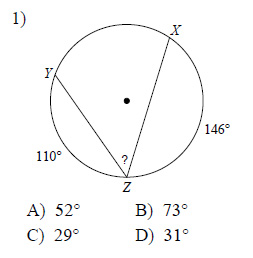Problem 1: The diameter of a cart wheel is 2.1 m. Find the distance traveled when it completes 100 revolutions. Solution: In order to find the distance covered in one revolution, we have to find the circumference of the circle. Problem solving - use acquired knowledge to solve word problems on area and circumference Additional Learning You'll be given a chance to learn even more about word problems regarding circles with. Problem Solving with GSP: Three tangent circles (Soddy circles) NuPenDekDee. Tangent Lines & Secant Lines of Circles, Walk Around Problem - Geometry - Duration: 19:16. Problem-Solving Circles Math Practice Standards 1. Make sense of problems and persevere in solving them. Reason abstractly and quantitatively. Construct viable arguments and critique the reasoning of others. College and Career Readiness Standards in Literacy Reading 1. This video shows how to solve three word problems, each a bit more challenging, from length of a rectangle, to angles of a triangle, to finding the length of each side of a triangle that is compared to a square. Example: (1) The longest runway at an airport has the shape of a rectangle and an area of 1,327,700 square feet. This runway is 110.
Classifying Angles
Angles Worksheets
Naming Angles
Angles Worksheets

Angle Pair Relationships
Angles Worksheets
Producing Protractor Images
Angles Worksheets
Reading a Protractor
Angles Worksheets
Measuring Angles
Angles Worksheets
Drawing Angles
Angles Worksheets
Identify if a Point is Interior
or Exterior to an Angle
Angle Addition Postulate
Angles Worksheets
Find Complementary Angles
Angles Worksheets
Math Problem Solving
Find Supplementary Angles
Angles Worksheets
Find Vertical Angles
Angles Worksheets
Find Alternate Angles
Angles Worksheets
Find Corresponding Angles
Angles Worksheets
Find All Angles
Angles Worksheets
Arcs and Central
Angles Worksheets
Inscribed Angles
Angles Worksheets
A Creative Problem Solving Tool
Solution Circle Live Demo Video
Designed by Jack Pearpoint, Marsha Forest & John O’Brien
This is a short and powerful tool that takes no more than a half hour. Its effective in getting “unstuck” from a problem in life or work. Solution Circles are tools to build “community capacity”. It assumes and demonstrates that nearby people – in any community or work place have the capacity to help if asked. It requires a person to ASK – not an easy thing in our culture of privacy and ‘do it alone’. This tool puts all the values we espouse into practice and demonstrates that TOGETHER WE’RE BETTER.
- Time required: No more than thirty minutes
- People per Solution circle: Best with 5-9
- Roles to be played:
- Problem Presenter (focus person)
- Process Facilitator (team manager, time keeper)
- Note Taker or Graphic Recorder
- Amazingly creative Brainstorm Team
- The greater the diversity in the team the better
Explain the steps to the teams in detail
Step One: (6 minutes)
The problem presenter will have 6 uninterrupted minutes to outline the problem. The job of the process facilitator is to keep time and make sure no one interrupts. The recorder takes notes. Everyone else (the brainstormers) listen. If the problem presenter stops talking before the six minutes elapse, everyone else stays silent until the 6 minutes pass. This is key! The problem presenter gets 6 uninterrupted minutes.
Step two: (6 minutes)

This is a brainstorm. Everyone chimes in with ideas about creative solutions to what they just heard. It is not a time to clarify the problem or to ask questions. It is not a time to give speeches, lectures or advice. The process facilitator must make sure this is a brainstorm/thought shower. Everyone gets a chance to give his or her brilliant ideas. No one must be allowed to dominate. The problem presenter listens – without interrupting. He/she must not talk or respond. We often give the person masking tape to facilitate their listening. It’s hard to just listen!
Step 3. (6 minutes)
Angle Math Problems
Now the group can have a dialogue led by the problem presenter. This is time to explore and clarify the problem. Focus on the positive points only and not what can’t be done.
Step 4: (6 minutes)
The First Step. The focus person and the group decide on first steps that are doable within the next few days. A coach from the group volunteers to phone or see the person within 3 days and check if they took their first step.
Solving For Angles
Finally the group just does a round of words to describe the experience and the recorder gives the record to the focus person. If in a large group, the teams returns to the main group, debrief and continue. In our experiences people love this exercise and find that it generates action. It does not guarantee a solution, but it usually gets people “unstuck” and at least points to the next logical step.
